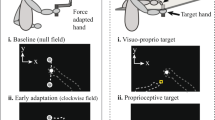Abstract
When an object is repeatedly grasped and lifted, the balance between grip force (normal to the object’s surface) and lift force (tangential to the object’s surface) is programmed according to the mechanical object features within a few lifts. Information related to the mechanical object properties is easily transferred in between both hands, and the cerebellum may play an essential role for the integration and generalization of this information. Recently, we have shown that the transfer of weight-related information in between both hands is impaired in cerebellar degeneration (Nowak et al., Neuropsychologia, 43:20–27, 2005). Here, we investigated the role of the cerebellum for the inter-manual transfer of friction-related information. Healthy subjects and patients with either focal or generalized cerebellar disorders first repeatedly lifted an object with one hand followed by a series of lifts of the same object with the opposite hand. The experiments were performed with the object’s grip surfaces covered with either silk or sandpaper. Patients and healthy subjects scaled grip force differentially to surface friction within a few lifts. However, the ability to transfer friction-related information from one hand to the other was disturbed in cerebellar patients. We interpret these data within the recent concept that the cerebellum is essential for the rapid integration and generalization of mechanical object features in between both hemispheres when handling objects in the environment.


Similar content being viewed by others
Notes
We interpret predictive force control within the theoretical framework of internal models being well aware that several theories exist. We have discussed the different theories of internal models within the context of human grip force control earlier in this journal [14]. Nevertheless, we wish to point out that the details of predictive force control have been known and well described long before the concepts of internal models have been developed.
References
Bastian AJ (2006) Learning to predict the future: the cerebellum adapts feedforward movement control. Curr Opin Neurobiol 16:645–649
Blakemore SJ, Frith CD, Wolpert DM (2001) The cerebellum is involved in predicting the sensory consequences of action. Neuroreport 12:1879–1884
Espinoza E, Smith AM (1990) Purkinje cell simple spike activity during grasping and lifting objects of different textures and weights. J Neurophysiol 64:698–714
Fellows SJ, Ernst J, Schwarz M, Töpper R, Noth J (2001) Precision grip in cerebellar disorders in man. Clin Neurophysiol 112:1793–1802
Flanagan JR, Johansson RS (2002) Hand movements. In: Ramshandran VS (ed) Encyclopedia of the human brain, vol 2. Academic, San Diego, pp 399–414
Gao JH, Parsons LM, Bower JM, Xiong J, Li J, Fox PT (1996) Cerebellum implicated in sensory acquisition and discrimination rather than motor control. Science 272:545–547
Gordon A, Forssberg H, Iwasaki N (1994) Formation and lateralization of internal representations underlying motor commands during precision grip. Neuropsychologia 32:555–568
Gordon A, Westling G, Cole K, Johansson R (1993) Memory representation underlying motor commands used during manipulation of common and novel objects. J Neurophysiol 69:1789–1796
Johansson RS, Westling G (1984) Roles of glabrous skin receptors and sensorimotor memory in automatic control of precision grip when lifting rougher or more slippery objects. Exp Brain Res 56:550–564
Manto M, Nowak DA, Schutter DJ (2006) Coupling between cerebellar hemispheres and sensory processing. Cerebellum 5(3):187–188
Middleton FA, Strick PL (1997) Cerebellar output channels. In: Schmahmann JD (ed) The cerebellum and cognition. Academic, San Diego, pp 61–82
Middleton FA, Strick PL (2000) Basal ganglia and cerebellar loops: motor and cognitive circuits. Brain Res Rev 31(2–3):236–250
Müller F, Dichgans J (1994) Dyscoordination of pinch and lift forces during grasp in patients with cerebellar lesions. Exp Brain Res 101:485–492
Nowak DA, Topka H, Timmann D, Boecker H, Hermsdörfer J (2007) The role of the cerebellum for predictive control of grasping. Cerebellum 6:7–17
Nowak DA, Hermsdörfer J, Marquardt C, Fuchs HH (2002) Grip and load force coupling during discrete vertical movements in cerebellar atrophy. Exp Brain Res 145:28–39
Nowak DA, Hermsdörfer J, Rost K, Timmann D, Topka H (2004) Predictive and reactive finger force control during catching in cerebellar degeneration. Cerebellum 3:227–235
Nowak DA, Hermsdörfer J, Timmann D, Rost K, Topka H (2005) Impaired generalization of weight-related information in cerebellar degeneration. Neuropsychologia 43:20–27
Nowak DA, Koupan C, Hermsdörfer J (2007) Formation and decay of sensorimotor and associative memory in object lifting. Eur J Appl Physiol 100:719–726
Serrien JD, Wiesendanger M (1999) Grip–load coordination in cerebellar patients. Exp Brain Res 128:76–80
Smith AM, Dugas C, Fortier P, Kalaska J, Picard N (1993) Comparing cerebellar and motor cortical activity in reaching and grasping. Can J Neurol Sci (Suppl) 3:S53–S61
Soteropoulos DS, Baker SN (2006) Cortico-cerebellar coherence during a precision grip task in the monkey. J Neurophysiol 95:1194–1206
Trouillas P, Takayanagi T, Hallett M, Currier RD, Subramory SH, Wessel K et al (1997) International cooperative ataxia rating scale for pharmacological assessment of the cerebellar syndrome. The Ataxia Neuropharmacology Committee of the World Federation of Neurology. J Neurol Sci 145:205–211
Wolpert DM, Miall RC, Kawato M (1998) Internal models in the cerebellum. Trends Cogn Sci 2:338–347
Wolpert DM, Flanagan JR (2001) Motor prediction. Curr Biol 11:R729–R732
Acknowledgment
This research was supported by a grant of the Felgenhauer-Stiftung der Deutschen Gesellschaft für Neurologie (DGN) to Dennis A. Nowak.
Author information
Authors and Affiliations
Corresponding author
Rights and permissions
About this article
Cite this article
Nowak, D.A., Hufnagel, A., Ameli, M. et al. Interhemispheric Transfer of Predictive Force Control During Grasping in Cerebellar Disorders. Cerebellum 8, 108–115 (2009). https://doi.org/10.1007/s12311-008-0081-5
Received:
Accepted:
Published:
Issue Date:
DOI: https://doi.org/10.1007/s12311-008-0081-5




